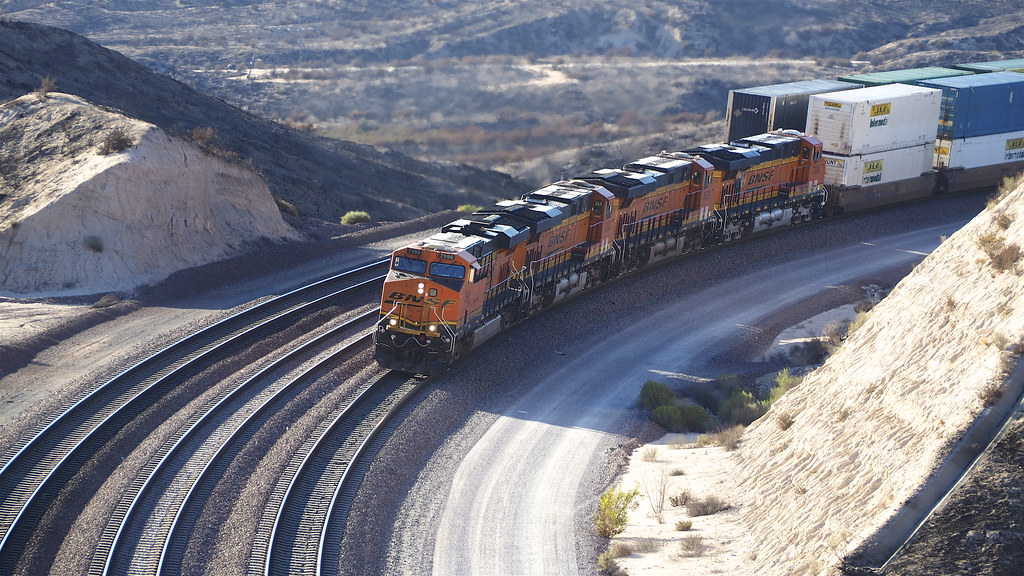
Cajon Pass (Summit) is a renowned train observation spot located in Southern California, where the San Bernardino and San Gabriel Mountains meet. It offers stunning views of trains navigating the steep grades and complex tracks, making it a favorite for railfans and photographers.
Photos
Sign in to upload photos
No Photos Yet
Be the first to share photos of this location!
Cajon Pass (Summit) – Hesperia, California, USA | Train Spotting Location
Trainspotting Experience
A typical visit begins along Forest Service roads that parallel the right-of-way; from pull-outs you can stand just yards from the ballast as trains grind upgrade at 15–25 mph or roar downgrade using dynamic brakes that echo across the canyon. Hill 582—an unofficial railfan overlook named for its elevation contour—provides a 360-degree view where you can watch trains enter from both the Mojave Desert side and the Inland Empire side, often meeting or overtaking right in front of you. Expect powerful GE ES44C4s, EMD SD70ACes, and distributed power units pushing or pulling on trains that routinely stretch to 10,000 ft. The noise is visceral: turbochargers howl, flange squeal reverberates through granite cuts, and the smell of hot traction motors lingers in the thin mountain air.
Landscape, Setting & Local Atmosphere
Summit sits at the abrupt transition between chaparral-covered slopes and open high-desert scrub. Joshua trees, pinyon pine, and scattered sagebrush frame rail shots against tawny ridges and, in winter, snow-dusted peaks of the San Gabriels. The air is typically clear, with visibility stretching 50 mi on low-humidity days; yet summer afternoons can bring shimmering heat haze, while spring often delivers crisp golden light. Winds are frequent and can be strong—helpful for dispersing dust kicked up by passing consists. Sunrise bathes eastbounds in warm side-light, while late-day sun silhouettes westbounds against pastel horizons.
Type & Frequency of Train Activity
Both BNSF Railway and Union Pacific use Cajon Pass as a primary gateway between Southern California ports and the rest of the nation. BNSF’s Cajon Subdivision—three main tracks—handles an average of 65–75 trains per 24 hr, heavily weighted toward double-stack intermodal, manifest freight, autoracks, and ethanol or crude oil unit trains. Union Pacific’s Mojave Subdivision adds roughly 20–25 trains daily, including northbound stack trains bound for the Central Valley and Nevada, as well as rock and military movements from the nearby Marine Corps Logistics Base. Passenger action is limited but notable: Amtrak’s Southwest Chief glides over the pass once each direction in the early morning and late evening, its Superliner cars providing a welcome splash of color amid the freight parade.
Best Angles for Photos & What Railfans Enjoy Most
• Hill 582: Elevated but close, ideal for wide-angle shots of three trains on three tracks, or telephoto compression of S-curves toward the High Desert.
• Highway 138 Overpass: Offers head-on views of trains cresting the grade with telegraph poles framing the skyline; best lit from mid-morning to early afternoon.
• Summit Valley Road Cut: Stand at rail level for dramatic low-angle photos of locomotives emerging from the granite walls; afternoon light illuminates nose and flanks.
Morning light favors eastbound trains climbing out of Cajon Creek, while golden-hour backlighting silhouettes westbound stacks against the vast Mojave sky. Night photography is productive thanks to minimal ambient light—long exposures capture star fields above streaking locomotive headlights.
Historical or Cultural Relevance
The original single-track Santa Fe line opened through Cajon Pass in 1885, effectively linking Los Angeles with the rest of the United States. A second track followed in 1913 to handle booming citrus and oil traffic. Southern Pacific (now UP) completed its Palmdale Cutoff in 1967, giving SP a lower-grade route to the ports and introducing competitive drama still felt today. BNSF’s 2008 third mainline project at Summit eliminated a decades-old bottleneck and stands as one of the largest recent capacity upgrades in U.S. mountain railroading. Artifacts of earlier eras—abandoned telegraph poles, concrete mileposts, and foundation remnants of helper-station cabins—dot the hillsides, silently narrating 140 years of rail history.
What Makes This Spot Different
Few locations combine triple-track mainline action, dual Class I competition, steep mountain grades, and unobstructed desert panoramas in one accessible package. Unlike tree-choked Appalachian hollows or remote Rocky Mountain passes, Cajon’s Summit allows railfans to watch trains for miles in both directions, providing ample warning for setup and multiple shooting angles from a single perch. The constant flow—often a train every 10 minutes during peak periods—means minimal downtime, while the mix of heavy manifest freights, high-priority stacks, and the occasional Amtrak consist keeps the scene varied and engaging.
Localisation
Coordonnées :34.348643, -117.450324
Seasonal Information
Cajon Pass (Summit) in Southern California is ideal for train watching year-round. Spring and fall offer mild weather and vibrant scenery. Summer provides long daylight hours, while winter can bring dramatic snow-capped views. Always check weather conditions and train schedules before visiting.
External Links
Other Interesting Locations
Looking for more spots? Browse the complete list of train spotting locations.
Quick Information
Country
USA
Region / State / Province
California
City
Hesperia
Spot Type
Scenic Overlook
Best Times
The best hours to observe trains at Cajon Pass (Summit) are during daylight, especially morning (7-10 AM) and late afternoon (3-6 PM) for optimal lighting and frequent train activity.
Access & Amenities
Parking
Not available
Shelter
Not available
Restrooms
Not available
